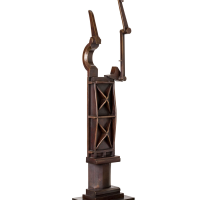ROBERT KLIPPEL

Robert Klippel is recognised as Australias most significant sculptor. It is thus no surprise that in advance of the National Gallery of Australia opening in Canberra in 1982, Klippel was commissioned by the founding director, James Mollison, to produce a public sculpture funded by the Federal Government. This commission led to the creation of a group of eight bronze cast works that became known as the Group of Eight. Amazingly, these were Klippels first major bronze cast sculptures, a medium which he is now famous for. The present work, No. 370, is one of a very limited edition of these pieces.
The Group of Eight were constructed from sections of pre-fabricated wooden parts that Klippel came across in 1964 and stored for seventeen years until deciding to use them for this commission. These wooden constructions were then cast in bronze by Peter Morley at his Meridian Foundry in Melbourne as artists proofs, from a proposed edition of six (edition five of sculpture No. 370 which we see here). The Group of Eight consisted of sculptures 365, 366, 367, 368, 369, 370 (the present work), 371 and 372. The artists proofs were then installed in the garden pond of the National Gallery of Australia Sculpture Park between July and October of 1982, ready for Her Majesty Queen Elizabeth IIs formal inauguration of the gallery on 12 October 1982.1
In No. 370, and indeed in all the Group of Eight works, the original industrial and mechanical components shed their once functional purposes and are reconfigured into a cohesive composition that conveys a sense of sculptural objecthood. The strong vertical format is evocative of both primitive carved burial totems, and a sentinel surveilling its surrounds, both of which carry a particular solemn dignity. It is Klippels practice of upcycling found objects that allows his sculptures to fit seamlessly into various historical and physical contexts. That is to say, by using existing objects to make new objects, he ensures an echo of something else that is dimly recognised by viewers, allowing them to fit in so many different environments without being directly related to them.2 Fellow artist and dear friend, James Gleeson, captured this pervasive relevance when he described these sculptures as having an archaic gravity.3
Footnotes
1. Wach, K., Robert Klippel: The American and European Years, Galerie Gmurzynska, Zrich, 2013, p.46-47
2. ibid. p.48
3. Gleeson, J., Robert Klippel, Bay Books, Sydney, 1983, p.413
Asta Cameron BA, MA (Art Curatorship)